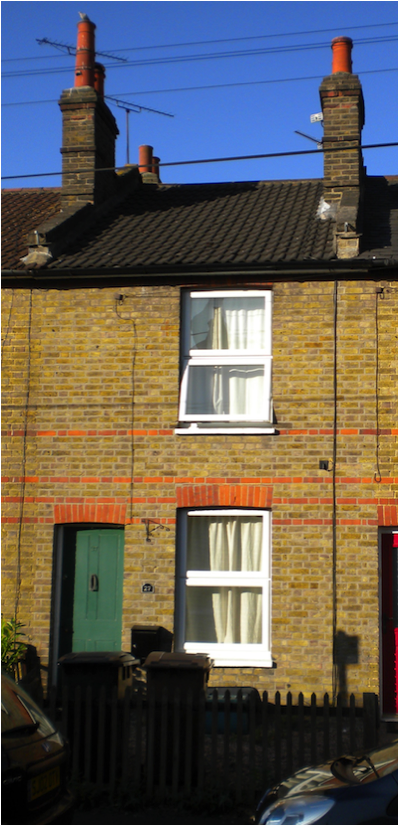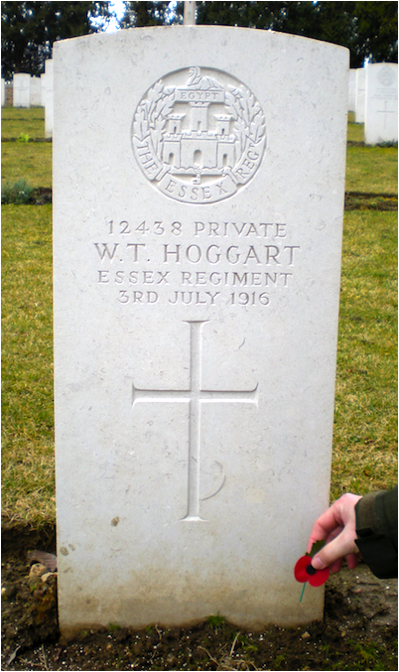William Thomas Hoggart (sometimes Hoggett or Hoggard) was born and brought up in Chelmsford where he worked at Hoffmann’s ball-bearing’s factory. He joined the army and was wounded in late 1915. Recovered, he returned to France and was killed in action on the third day of the Battle of the Somme in July 1916. His home was in South Primrose Hill.
HOGGART, WILLIAM THOMAS,
Private, 9th (Service) Battalion, Essex Regiment
Two platoons of B Company got over the German front line and where then held up by a high command Circular Trench which overlooked the ground they had won. The remainder of B Company and A Company almost reached the German line and were then held up by machine gun fire from Circular Trench which had stayed the advance of the other portion of B Company. D Company also made progress on the left, but they too, were stopped by the machine guns of Circular Trench, the wire of which had been renewed after the British bombardment had ceased.
Survivors from the enemy front line had sought shelter in this miniature fortress when the Brigade advanced and delivered therefrom the bombing attacks which were to have a potent effect on staying the Brigade’s offensive. The first to feel the influence of thus counter-attack were the two plattons of B Company, which were forced back. sadly depleted to the

William was born in Chelmsford in 1895 (when his forenames were recorded as ‘Thomas William’, the son of Alfred James Hoggart and Harriet Eliza Mead Hoggart (nee Devenish). His father had been born in Chelmsford in 1867; his mother in Springfield in 1862. In 1891 the couple had been resident at 6 Coval Road, Chelmsford with their daughter and William’s maternal grandmother.
William’s two siblings were Maud Hoggart (born in 1889 in Great Leighs) and Alfred James Hoggart (born in 1891 in Chelmsford).
The 1901 census found five year-old William living with his two siblings and parents near the Rose and Crown Inn at Rainsford End, Chelmsford. His father was employed as a maltster. In 1910 and 1913 the Hoggarts were living at 63 South Primrose Hill, Chelmsford. In between, the 1911 census found 16 year-old William living there with his parents, two siblings and a boarder. William’s father was a maltster; his sister was a laundress while William and the lodger were general labourers at Hoffmann’s ball-bearing factory in Chelmsford. William’s brother was a machinist there too. The house was renumbered as number 75 soon afterwards.
William lived and enlisted at Chelmsford, serving as Private 12438 in the 9th (Service) Battalion of the Essex Regiment. His battalion was part of the 35th Brigade in the 12th
(Eastern) Division, one of six Divisions which together formed the first part of ‘Kitchener’s Army’ from August 1914. The battalion was raised at Shornecliffe in Kent. The battalion had landed in France at the end of May/start of June 1915, entering the front line in July 1915 near Ploegsteert Wood, Belgium, close to the French border, a comparatively quiet sector.
On 5th November 1915 the Essex County Chronicle reported that William had been wounded:
“Pt. W. T. Hoggart, 9th Essex Regiment, son of Mr. A. Hoggart, 75 South Primrose Hill, Chelmsford, is wounded and in the Red Cross Hospital, Torquay.”
William recovered after six weeks and returned to his regiment.
In July 1916 William’s battalion participated in the Battle of the Somme. A post war regimental history reported:
“The Battalion was in reserve at Henencourt Wood [west of Albert] during the eventful daylight hours of July 1st. At 6.30 p.m. it moved through the village, the march being hampered by the blocking of the roads to Albert by other troops also marching up to the line in relief of the 8th Division, which had suffered severely. The 9th Essex occupied the line opposite Ovillers [north-east of Albert] on July 2nd. They were in support of the 5th Royal Berks and 7th Suffolks and during the day took shelter in the railway cutting near Marmont bridge from possible hostile counter bombardment whilst the 19th Division was operating against La Boisselle.
Orders were received that the Brigade was to attack Ovillers in the early morning of July 4th, but the time was subsequently altered to 3 a.m. on the 3rd , which prevented the thorough reconnaissance of the ground which had been planned. The Battalion occupied the following communication trenches - B Company in St. Vincent, C Company in Furness Street, A Company in Barrow Street and D Company in Mitchell Street, with Battalion headquarters in Ryecroft Street. Each company had its head in touch with the rear platoons of the leading battalion of the Brigade. Berkshires and Suffolks assembled in Border Street.
‘The march of the Battalion’. wrote a member of the 9th, ‘to take up position in this first Somme battle will for ever be remembered by those engaged. Innumerable gun flashes lit the darkness of the night; they seemed endless and as one approached the line, the noise was deafening. After what appeared to be endless marching we reached the trenches in front of Ovillers. They were of hard chalk and with the bad weather not all that easy to negotiate without trench boards. In moving to positions for attack, the congestion in the trenches was awful and mortally wounded men could not be moved, Zero hour arrived when it was raining, visibility was poor, with bitter retaliation by way of machine gun fire from the enemy’.
At 2.15 everything was ready, when a message was received that zero hour had been changed to 3.7 a.m. The attack took place promptly to time after a heavy bombardment and at 3.20 a.m. the leading lines of the Battalion followed in support. Considerable difficulty had been experienced in reaching the front line and the last of the Berkshires and Suffolks had disappeared into the darkness before the first Company had leapt the parapet in support. The direction of the attack was 90 degrees magnetic; that is to say, in a quarter left direction from the front line. Direction was not well maintained, chiefly because the objectives were indistinguishable and the jumping-off places were not square to the enemy line.
This difficulty notwithstanding, however, the leading battalions over-ran the enemy’s front and support lines and parties entered Ovillers, together with men of the 9th Essex. The latter unit had suffered severely whilst crossing the open ground by machine gun fire from the flanks and the village, and the waves became a series of detached parties under either an officer or N.C.O. A, D and three plattons of B Company had advanced in platoon waves, but the lines were not always in touch, the initial cause being the difficulty of getting the companies deployed along the front trench so as to move simultaneously owing to their damaged condition and the number of wounded and other details making their way back by the communication trenches up which the 9th Essex had groped their way.

German front line.
Battalion headquarters had been in the meantime moved to the junction of St. Vincent Street and Border Street, and no information having come to hand, Lieut.-Colonel Lewes and Adjutant went forward to ascertain the situation. Parties could be seen coming back on the right of the 36th Brigade, which had attacked with the 35th Brigade.. and later other parties sought to return on the right flank of the Brigade.
A small detachment of the Essex, about fifty men, started digging in on a small ridge or bank which overlooked the enemy’s first line and extra tools for that purpose were sent up by the 7th Norfolks. Information was very difficult to obtain and of news of the exact whereabouts of the Berkshires and Suffolks there was none. About 4 a.m. the attack had come to a standstill and the survivors withdrew again to the front line.. where the 7th Norfolks took over and enabled the Essex to reorganise in Ribble Street.
A curious mistake occurred during the attack, which deprived the Battalion of C Company (Kennefick), but which had, by happy mischance, the fortunate result of materially assisting the capture of La Boisselle. C Company were on the left of B Company and should have advance in line with them, but they lost touch and, moving in a south-easterly direction in lines of platoons. straight across Mash Valley, tehy struck the German lines north-west of La Boisselle. They carried the enemy front and support trenches and went right through the village, where they met the Royal Welsh Fusiliers and Gloucesters, of the 19th Division, who were advancing upon La Boisselle from the opposite direction.
Much bomb fighting ensued in the village and when C Company were withdrawn at 2 p.m. only the north-western corner remained in German occupation. C Company secured 150 prisoners in their bold essay, who were handed over to the 19th Division for safe conduct to Albert. Thus, although Ovillers remained untaken, La Boisselle, another strongly fortified point in the line, had succumbed to the bold attack of C Company. ‘Though there was a grave error’, wrote the Battalion Commander, ‘in the initial leading and the attack on Ovillers was deprived of a whole company, which may or may not have made all the difference, I would like to point out that the handling and conduct of the Company from this point were most creditable, especially as it was considerably shaken by the bombardment of our trenches just before the attack from which Furness Street suffered badly’...Twelve officers and 386 other ranks were returned as casualties or missing.”
At some during that day, the 3rd July 1916, William was killed in action, one of 110 men from the Battalion who are listed as killed that day by the Commonwealth War Graves Commission. Today he lies at Aveluy Communal Cemetery Extension, Somme, France (grave: F. 40), some two miles west of Ovillers. The cemetery also contains 19 other British soldiers who died that day, including two comrades from William’s battalion. Another Chelmsford man, also serving in the 9th (Service) Battalion of the Essex Regiment, Harold Percival Nevard, was killed that day, though he has no known grave.
William’s death was mentioned by the Essex Weekly News on 4th August 1916:
“Pte. William Hoggett [sic], Essex Regt., killed in action on July 3, was 21 years of age, and the son of Mrs. Hoggett [sic], of 75, South Primrose-hill, Chelmsford. He was wounded last October, but recovered after six weeks and rejoined his regiment.”
The Essex County Chronicle of 11th August 1916 carried a short report on his death:
“Pt. Wm. Hoggett, Essex R., killed in action on July 3, was 21 years of age, and the son of Mrs. Hoggett, of 75 South Primrose Hill, Chelmsford.”
William is commemorated on the Civic Centre Memorial, Chelmsford. He was entitled to the Victory, British War and 1915 Star medals.
His brother had married Violet Emily Willet in 1913 and they lived at 10 Embankment Terrace in 1918; his sister married Frederick G. Wilson in 1919, but she died just four years later. In another tragedy Violet committed suicide in 1932.
The 1918 register of electors showed William’s parents still at 75 South Primrose Hill; and his father was still there in 1940 according to a later street directory. The property was renumbered once again in 1946, becoming number 27. William’s mother died in 1943, aged 81. His father died seven years later, aged 83.
William was one of the ‘South Primrose Hill Boys’.
131101
